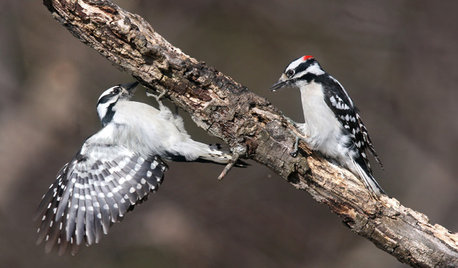two separate issues on bugs
Suzanne
16 years ago
Related Stories

GARDENING AND LANDSCAPINGPorch Life: Banish the Bugs
Don't let insects be the bane of your sweet tea and swing time. These screening and product ideas will help keep bugs at bay on the porch
Full Story
GARDENING AND LANDSCAPINGBreezy and Bug-Free Modern Porches
Screening keeps pests out of these diverse porches across the U.S., while thoughtful designs keep them visually appealing
Full Story
GARDENING FOR BIRDSBackyard Birds: How to Identify Two Common Woodpeckers
Downy and hairy woodpeckers have similar coloration and behavior. But there are two big differences that separate them
Full Story
EARTH DAYHow to Help Your Town’s Beneficial Birds and Bugs
Make a habitat using local materials to provide a home to the creatures that help our gardens
Full Story
ARCHITECTUREDesign Workshop: How to Separate Space in an Open Floor Plan
Rooms within a room, partial walls, fabric dividers and open shelves create privacy and intimacy while keeping the connection
Full Story
BATHROOM VANITIESShould You Have One Sink or Two in Your Primary Bathroom?
An architect discusses the pros and cons of double vs. solo sinks and offers advice for both
Full Story
LIFEHouzz Call: Show Us Your Two-Cook Kitchen
Do you share your kitchen with a fellow cook? We want to see how you make it work
Full Story
KITCHEN DESIGNA Two-Tone Cabinet Scheme Gives Your Kitchen the Best of Both Worlds
Waffling between paint and stain or dark and light? Here’s how to mix and match colors and materials
Full Story
MIDCENTURY HOMESMy Houzz: Two Decades Hone a Ju-Nel Home to Perfection
'Well-marinated' renovations turn a 1959 home in Dallas into a comfortable, open modernist wonder
Full Story
COMMUNITYTwo Homes Focus on Community
Energy-efficient houses in New Zealand adopt a neighborly point of view
Full Story






rhizo_1 (North AL) zone 7
SuzanneOriginal Author
Related Professionals
Clark Landscape Architects & Landscape Designers · Dudley Landscape Contractors · Estelle Landscape Contractors · Euclid Landscape Contractors · Galt Landscape Contractors · Huntley Landscape Contractors · Mastic Beach Landscape Contractors · Middle River Landscape Contractors · Mount Kisco Landscape Contractors · North Potomac Landscape Contractors · Plymouth Landscape Contractors · South Portland Landscape Contractors · Wallingford Landscape Contractors · Palos Heights Landscape Contractors · Rocky Point Swimming Pool BuildersKimmsr
rhizo_1 (North AL) zone 7
swampthing_grower
rhizo_1 (North AL) zone 7